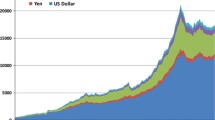Abstract
This paper investigates the cross-country transmission mechanisms of monetary shocks between Australia and New Zealand within a VAR framework for the period 1985:1–2003:4. The empirical results indicate that a monetary shock in either Australia or New Zealand has real effects in the short-run in both countries however, an Australian shock generates more significant responses of most variables. Australian output is found to be significantly more sensitive than New Zealand output to monetary innovations in either country. The results also suggest that monetary innovations in a small open economy can also influence its larger trading partner.
Similar content being viewed by others
References
Australian Government Department of Foreign Affairs and Trade. (2003) Trade 2003 online. Retrieved October 29, 2004 from the World Wide Web: http://www.dfat.gov.au/trade/trade2003/chapter_04.html#newZealand.
Bernanke, B.; Blinder, A. “The Federal Funds Rate and the Channels of Monetary Transmission,” American Economic Review, 82, 4, 1992, pp. 901–21.
Betts, C.; Devereux, M. B. “The International Effects of Monetary and Fiscal Policy in a Two-Country Model,” in Money, Capital Mobility: Essays in Honor of Robert A. Mundell, G. A. Calvo, R. Dornbusch, M. Obstfeld (eds.), Cambridge, MA: MIT Press, 2000.
Buckle, R.; Kim, K.; Kirkham, H.; McLellan, N.; Sharma, J. “A Structural VAR Model of the New Zealand Business Cycle,” New Zealand Treasury, Working Paper 02/26, 2002.
Buckle, R.; Kim, K.; McLellan, N. “The Impact of Monetary Policy on New Zealand Business Cycles and Inflation Variability,” New Zealand Treasury, Working Paper 03/09, 2003.
Christiano, L.; Eichenbaum, M.; Evans, C. “The Effects of Monetary Policy Shocks: Evidence from the Flow of Funds,” Review of Economics and Statistics, 78, 1996, pp. 16–34.
—. “Monetary Policy Shocks: What Have We Learned and to What End?” NBER, Working Paper No. 6400, 1998.
Conway, P. “Macroeconomic Variability in New Zealand: An SVAR Study,” New Zealand Economic Papers, 32, 2, 1998, pp. 161–86.
Cushman, D.O.; Zha, T. A. “Identifying Monetary Policy in a Small Open Economy Under Flexible Exchange Rates,” Journal of Monetary Economics, 39, 3, 1997, pp. 433–48.
Dungey, M.; Pagan, A. “A Structural VAR Model of the Australian Economy,” The Economic Record, 76, 2000, pp. 321–42.
Eichenbaum, M. “Comments on Interpreting the Macroeconomic Time Series Facts: The Effects of Monetary Policy,” European Economic Review, 36, 5, 1992, pp. 1001–11.
Eichenbaum, M.; Evans, C. “Some Empirical Evidence on the Effects of Monetary Policy Shocks on Exchange Rates,” Quarterly Journal of Economics, 110, 1995, pp. 975–1010.
Grilli, V.; Roubini, N. Liquidity and Exchange Rates: Puzzling Evidence from the G-7 Countries, Yale University, CT: Working Paper, 1995.
Holman, J.; Neumann, R. “Evidence on the Cross-Country Transmission of Monetary Shocks,” Applied Economics, 34, 2002, pp. 1837–57.
Joyce, J. P.; Kamas, L. “Money and Output Under Alternative Exchange Rate Regimes in the USA,” Journal of International Money and Finance, 13, 1994, pp. 679–97.
Kim, S. “International Transmission of U.S. Monetary Policy Shocks: Evidence from VARs,” Journal of Monetary Economics, 48, 2001, pp. 339–72.
Kim, S.; Roubini, N. “Exchange Rate Anomalies in the Industrial Countries: A Solution with a Structural VAR Approach,” Journal of Monetary Economics, 45, 2000, pp. 561–86.
Koray, F.; McMillin, W.D. “Monetary Shocks, the Exchange Rate, and the Trade Balance,” Journal of International Money and Finance, 18, 1999, pp. 925–40.
Lastrapes, W.D.; Koray, F. “International Transmission of Aggregate Shocks Under Fixed and Flexible Exchange Rate Regimes: United Kingdom, France, and Germany, 1959 to 1985,” Journal of International Money and Finance, 9, 1990, pp. 402–23.
Sims, C.A. “Macroeconomics and Reality,” Econometrica, 48, 1980, pp. 1–48.
—. “Interpreting the Macroeconomic Time Series Facts: The Effects of Monetary Policy,” European Economic Review, 36, 1992, pp. 975–1000.
Strongin, S. “The Identification of Monetary Policy Disturbances: Explaining the Liquidity Puzzle,” Journal of Monetary Economics, 35, 3, 1995, pp. 463–97.
Author information
Authors and Affiliations
Additional information
The authors would like to thank Faik Koray and an anonymous referee for their valuable comments. The usual disclaimer applies.




